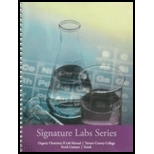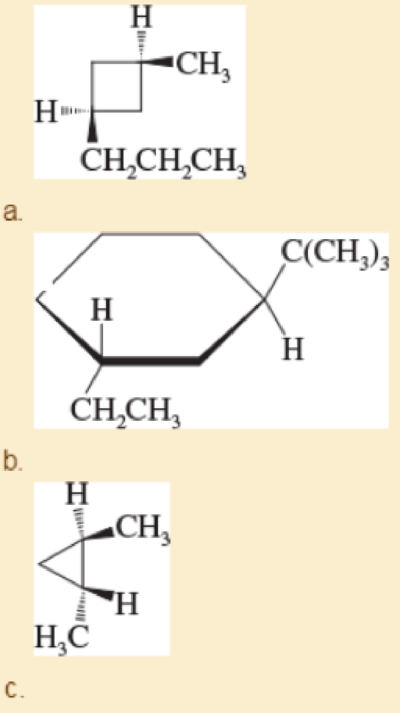
ORGANIC CHEMISTRY II LAB MANUAL>CUSTOM<
9th Edition
ISBN: 9780534261641
Author: SIMEK
Publisher: Cengage Learning
expand_more
expand_more
format_list_bulleted
Concept explainers
Textbook Question
Chapter 3.11, Problem 3.18P
Give IUPAC names for the following cycloalkanes.

Expert Solution & Answer
Want to see the full answer?
Check out a sample textbook solution
Students have asked these similar questions
How many mL of H2O2 from the 30% bottle must be collected to prepare 6 mL of 6% H2O2.
Indicate the product(s) B and C that are formed in the
reaction:
HN'
OCH
HC1
B +
mayoritario
C
minoritario
OCH3
Indicate the product(s) that are formed in the reaction:
NH-NH,
OCH3
-H₂O
OCH3
Chapter 3 Solutions
ORGANIC CHEMISTRY II LAB MANUAL>CUSTOM<
Ch. 3.2 - Using the general molecular formula for alkanes:...Ch. 3.3B - Name the following alkanes and haloalkanes. When...Ch. 3.3B - Write structures for the following compounds. a....Ch. 3.3B - Provide IUPAC names for the following compounds....Ch. 3.3B - Prob. 3.5PCh. 3.3B - Prob. 3.6PCh. 3.3B - Prob. 3.7PCh. 3.3B - Draw the structures of the following compounds. a....Ch. 3.3B - Without looking at the structures, give molecular...Ch. 3.4C - Prob. 3.10P
Ch. 3.7B - Prob. 3.11PCh. 3.7C - Draw a graph similar to Figure 3-9, of the...Ch. 3.8B - Draw a graph similar to Figure 3-11, of the...Ch. 3.9 - Draw a perspective representation of the most...Ch. 3.10C - Give IUPAC names for the following compounds.Ch. 3.10C - Draw the structure and give the molecular formula...Ch. 3.11 - Which of the following cycloalkanes are capable of...Ch. 3.11 - Give IUPAC names for the following cycloalkanes.Ch. 3.12B - The heat of combustion of...Ch. 3.12C - Prob. 3.20PCh. 3.13B - The cyclohexane chair shown in Figure 3-22 has the...Ch. 3.13B - Draw 1,2,3,4,5,6-hexamethylcyclohexane with all...Ch. 3.14 - Prob. 3.23PCh. 3.14 - Prob. 3.24PCh. 3.14 - Draw the most stable conformation of a....Ch. 3.15 - Prob. 3.26PCh. 3.15 - a. Draw both chair conformations of cis-1...Ch. 3.15 - Prob. 3.28PCh. 3.15A - Draw the two chair conformations of each of the...Ch. 3.15B - Draw the most stable conformation of a....Ch. 3.16A - Name the following compounds.Ch. 3.16B - Prob. 3.32PCh. 3 - Prob. 3.33SPCh. 3 - Prob. 3.34SPCh. 3 - 3-35 a. Draw and name the five cycloalkane...Ch. 3 - Draw the structure that corresponds with each...Ch. 3 - Each of the following descriptions applies to more...Ch. 3 - Write structures for a homologous series of...Ch. 3 - Prob. 3.39SPCh. 3 - Construct a graph, similar to Figure 3-11, of the...Ch. 3 - The following names are all incorrect or...Ch. 3 - In each pair of compounds, which compound has the...Ch. 3 - There are eight different five-carbon alkyl...Ch. 3 - Use a Newman projection about the indicated bond...Ch. 3 - a. Draw the two chair conformations of...Ch. 3 - Draw the two chair conformations of each compound,...Ch. 3 - Using what you know about the conformational...Ch. 3 - Prob. 3.48SPCh. 3 - Draw Newman projections along the C3C4 bond to...Ch. 3 - Prob. 3.50SPCh. 3 - The most stable form of the common sugar glucose...Ch. 3 - This is a Newman projection of a substituted...
Knowledge Booster
Learn more about
Need a deep-dive on the concept behind this application? Look no further. Learn more about this topic, chemistry and related others by exploring similar questions and additional content below.Similar questions
- 21.38 Arrange the molecules in each set in order of increasing acidity (from least acidic to most acidic). OH OH SH NH2 8 NH3 OH (b) OH OH OH (c) & & & CH3 NO2 21.39 Explain the trends in the acidity of phenol and the monofluoro derivatives of phenol. OH OH OH OH PK 10.0 PK 8.81 PK 9.28 PK 9.81arrow_forwardidentify which spectrum is for acetaminophen and which is for phenacetinarrow_forwardThe Concept of Aromaticity 21.15 State the number of 2p orbital electrons in each molecule or ion. (a) (b) (e) (f) (c) (d) (h) (i) DA (k) 21.16 Which of the molecules and ions given in Problem 21.15 are aromatic according to the Hückel criteria? Which, if planar, would be antiaromatic? 21.17 Which of the following structures are considered aromatic according to the Hückel criteria? ---0-0 (a) (b) (c) (d) (e) (h) H -H .8.0- 21.18 Which of the molecules and ions from Problem 21.17 have electrons donated by a heteroatom?arrow_forward
- 1. Show the steps necessary to make 2-methyl-4-nonene using a Wittig reaction. Start with triphenylphosphine and an alkyl halide. After that you may use any other organic or inorganic reagents. 2. Write in the product of this reaction: CH3 CH₂ (C6H5)₂CuLi H₂O+arrow_forward3. Name this compound properly, including stereochemistry. H₂C H3C CH3 OH 4. Show the step(s) necessary to transform the compound on the left into the acid on the right. Bri CH2 5. Write in the product of this LiAlH4 Br H₂C OHarrow_forwardWhat are the major products of the following reaction? Please provide a detailed explanation and a drawing to show how the reaction proceeds.arrow_forward
- What are the major products of the following enolate alkylation reaction? Please include a detailed explanation as well as a drawing as to how the reaction proceeds.arrow_forwardA block of zinc has an initial temperature of 94.2 degrees celcius and is immererd in 105 g of water at 21.90 degrees celcius. At thermal equilibrium, the final temperature is 25.20 degrees celcius. What is the mass of the zinc block? Cs(Zn) = 0.390 J/gxdegrees celcius Cs(H2O) = 4.18 J/gx degrees celcusarrow_forwardPotential Energy (kJ) 1. Consider these three reactions as the elementary steps in the mechanism for a chemical reaction. AH = -950 kJ AH = 575 kJ (i) Cl₂ (g) + Pt (s) 2C1 (g) + Pt (s) Ea = 1550 kJ (ii) Cl (g)+ CO (g) + Pt (s) → CICO (g) + Pt (s) (iii) Cl (g) + CICO (g) → Cl₂CO (g) Ea = 2240 kJ Ea = 2350 kJ AH = -825 kJ 2600 2400 2200 2000 1800 1600 1400 1200 1000 a. Draw the potential energy diagram for the reaction. Label the data points for clarity. The potential energy of the reactants is 600 kJ 800 600 400 200 0 -200- -400 -600- -800- Reaction Progressarrow_forward
- Can u help me figure out the reaction mechanisms for these, idk where to even startarrow_forwardHi, I need your help with the drawing, please. I have attached the question along with my lab instructions. Please use the reaction from the lab only, as we are not allowed to use outside sources. Thank you!arrow_forwardHi, I need your help i dont know which one to draw please. I’ve attached the question along with my lab instructions. Please use the reaction from the lab only, as we are not allowed to use outside sources. Thank you!arrow_forward
arrow_back_ios
SEE MORE QUESTIONS
arrow_forward_ios
Recommended textbooks for you
 Introductory Chemistry: An Active Learning Approa...ChemistryISBN:9781305079250Author:Mark S. Cracolice, Ed PetersPublisher:Cengage LearningChemistry: Matter and ChangeChemistryISBN:9780078746376Author:Dinah Zike, Laurel Dingrando, Nicholas Hainen, Cheryl WistromPublisher:Glencoe/McGraw-Hill School Pub Co
Introductory Chemistry: An Active Learning Approa...ChemistryISBN:9781305079250Author:Mark S. Cracolice, Ed PetersPublisher:Cengage LearningChemistry: Matter and ChangeChemistryISBN:9780078746376Author:Dinah Zike, Laurel Dingrando, Nicholas Hainen, Cheryl WistromPublisher:Glencoe/McGraw-Hill School Pub Co Organic And Biological ChemistryChemistryISBN:9781305081079Author:STOKER, H. Stephen (howard Stephen)Publisher:Cengage Learning,
Organic And Biological ChemistryChemistryISBN:9781305081079Author:STOKER, H. Stephen (howard Stephen)Publisher:Cengage Learning, General, Organic, and Biological ChemistryChemistryISBN:9781285853918Author:H. Stephen StokerPublisher:Cengage Learning
General, Organic, and Biological ChemistryChemistryISBN:9781285853918Author:H. Stephen StokerPublisher:Cengage Learning Chemistry for Today: General, Organic, and Bioche...ChemistryISBN:9781305960060Author:Spencer L. Seager, Michael R. Slabaugh, Maren S. HansenPublisher:Cengage Learning
Chemistry for Today: General, Organic, and Bioche...ChemistryISBN:9781305960060Author:Spencer L. Seager, Michael R. Slabaugh, Maren S. HansenPublisher:Cengage Learning

Introductory Chemistry: An Active Learning Approa...
Chemistry
ISBN:9781305079250
Author:Mark S. Cracolice, Ed Peters
Publisher:Cengage Learning


Chemistry: Matter and Change
Chemistry
ISBN:9780078746376
Author:Dinah Zike, Laurel Dingrando, Nicholas Hainen, Cheryl Wistrom
Publisher:Glencoe/McGraw-Hill School Pub Co

Organic And Biological Chemistry
Chemistry
ISBN:9781305081079
Author:STOKER, H. Stephen (howard Stephen)
Publisher:Cengage Learning,

General, Organic, and Biological Chemistry
Chemistry
ISBN:9781285853918
Author:H. Stephen Stoker
Publisher:Cengage Learning

Chemistry for Today: General, Organic, and Bioche...
Chemistry
ISBN:9781305960060
Author:Spencer L. Seager, Michael R. Slabaugh, Maren S. Hansen
Publisher:Cengage Learning
Chapter 4 Alkanes and Cycloalkanes Lesson 2; Author: Linda Hanson;https://www.youtube.com/watch?v=AL_CM_Btef4;License: Standard YouTube License, CC-BY
Chapter 4 Alkanes and Cycloalkanes Lesson 1; Author: Linda Hanson;https://www.youtube.com/watch?v=PPIa6EHJMJw;License: Standard Youtube License